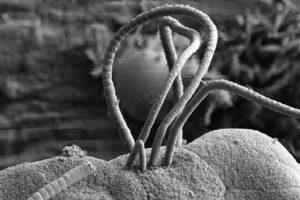

Mice that lack B and T cells (Rag1-knockout mice) develop chronic infection after oral inoculation with rotavirus, which causes gastroenteritis in humans. While breeding these mice at Georgia State, a line was obtained that was resistant to infection. Resistance to infection could be transferred to the original Rag1-knockout mouse line by co-housing or administration of feces from resistant mice. These observations suggested that a transmissible microbe is present in feces of mice resistant to rotativirus.
A single species of bacteria, Candidatus arthromitus or segmented filamentous bacteria (pictured), were found to be responsible for resistance of Rag1-knockout mice to infection with rotavirus. The bacteria were apparently introduced into the original Rag1-knockout mice during breeding at Georgia State. The bacteria prevent infection in at least two ways: by altering the gut epithelium, causing increased shedding of infected epithelial cells, and by interacting with virus particles to prevent infection.
These observations have at least two implications for rotavirus infections in humans. Not all humans carry segmented filamentous bacteria in their gut tracts. Infants and young children in China do not have severe rotavirus disease and also carry segmented filamentous bacteria. Whether human rotavirus infections are in general regulated by these bacteria should be studied. The rotavirus vaccine, an infectious, orally delivered preparation, is not effective in blocking infection in all countries. The presence of segmented filamentous bacteria in the gut tracts might be responsible for poor vaccine-induced protection.
These findings suggest that other commensal bacteria might prevent virus infections, a possibility that deserves careful study to not only reveal mechanisms of infection but to suggest new antiviral approaches.
